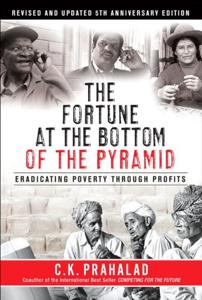
Want to learn the ideas in The Fortune At the Bottom of the Pyramid better than ever? Read the world’s #1 book summary of The Fortune At the Bottom of the Pyramid by C.K. Prahalad here.
Read a brief 1-Page Summary or watch video summaries curated by our expert team. Note: this book guide is not affiliated with or endorsed by the publisher or author, and we always encourage you to purchase and read the full book.
Video Summaries of The Fortune At the Bottom of the Pyramid
We’ve scoured the Internet for the very best videos on The Fortune At the Bottom of the Pyramid, from high-quality videos summaries to interviews or commentary by C.K. Prahalad.
1-Page Summary of The Fortune At the Bottom of the Pyramid
A New Approach to the Problem of Poverty
For years, we’ve thought that poor countries are so because they don’t have resources. We also think that helping them with health care and education is the best way to reduce poverty. Lastly, rich countries can help poor ones by building infrastructure.
DeSoto showed that the poor are not really poor, but they lack capital. To become wealthy, people need to have assets and be able to convert them into other forms of wealth. A government can’t just give money away in order for its citizens to become rich; it needs a system of laws that allows for the transfer of ownership from one person to another. Although many countries try this by giving financial aid or loans, only a few such programs work because most governments don’t have good legal systems in place.
Poverty reduction programs and development efforts guided by the above assumptions have not been successful. In fact, they haven’t even reduced poverty or stimulated economic growth. A new approach is needed to solve this problem, one that takes into account several considerations like these:
The poor in the world have more potential capital than all of the philanthropic and aid efforts available to them. The paradox is that they look rich on paper, but because they don’t have a stable legal system or rule of law, their economic life revolves around extralegal activities such as black market trading. This makes it difficult for businesses to attract investment capital and grow.
The solution to poverty is not traditional aid, but helping people become entrepreneurs and consumers. It’s about reframing the conversation to focus on underserved markets and consumers. It’s a process of co-creation that requires marketers to treat BOP consumers with respect and regard them as participants in the process of development. They are not victims; they’re creative entrepreneurs who demand quality products. A partnership with these entrepreneurs will help develop their economies by creating jobs and attracting innovative products that meet their unique needs—a win-win situation for everyone involved, including companies doing business there.
Ideological beliefs, normal experiences and business habits present impediments. To discover the fortune at the bottom of the pyramid, society must challenge its assumptions. For instance, it is incorrect to assume that because poor people have no money individually they collectively are not a market. In fact, they comprise a vast potential market with many intermediaries keeping them poor by charging high prices for products and services as well as interest rates on loans. A bank can offer an alternative source of capital by making lower-interest loans to these individuals who live in shantytowns or slums near Mumbai (or other parts of India).
Companies often overlook the BOP market because they believe it’s too difficult to reach. However, many people in this market live in urban areas that are densely populated, which means distribution isn’t as challenging as you might think. Of course, rural residents may be more of a challenge since they’re harder to reach with radio and TV. Wireless Internet access could help solve that problem in the future.
BOP consumers are very aware of brands and technology. They will always take advantage of the latest technology to achieve an economic edge if possible. For example, farmers in India’s farming communities have access to cellphones so they can check the price of soybean futures from Chicago and know when it’s best for them to sell their harvests at a better price. Fishermen use similar methods using cellphones, enabling them to get bids from potential buyers and maximize profits by selling their fish at top dollar.






